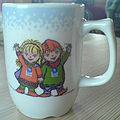- List of Olympic mascots
-
See also: List of Paralympic mascots
The Olympic mascot(s) is(are) a character, usually an animal native to the area or occasionally human figures, who represents the cultural heritage of the place where the Olympic and Paralympic Games are taking place.
Since the 1968 Winter Olympics in Grenoble, France the Olympic Games have had a mascot. The first major mascot in the Olympic Games was Misha in the 1980 Summer Olympics in Moscow. Misha was used extensively during the opening and closing ceremonies, had a TV animated cartoon and appeared on several merchandise products.
Starting with the 2010 Vancouver mascots, the Olympic and Paralympic mascots have been presented together.
Contents
List of mascots
Games City Mascot Character Designer Significance Picture 1968 Winter Olympics Grenoble Schuss Stylized skier Mme Lafargue (unofficial) 1968 Summer Olympics Mexico City El Jaguar Rojo de Chichen-Itza Red jaguar Based on a throne in the shape of a red jaguar in the "El Castillo" pyramid at Chichen Itzá. Paloma de la Paz Dove Eduardo Terrazas and Lance Wyman A stylized white dove, it represented the slogan of the games, "Los juegos de la Paz", ("Games of the Peace"). File:Mexico'68 Olympics 1972 Summer Olympics Munich Waldi Dachshund dog Otl Aicher A popular breed in Bavaria, it represented the attributes required for athletes - resistance, tenacity and agility. 1976 Winter Olympics Innsbruck Schneemann Snowman It represents the Games of Simplicity. 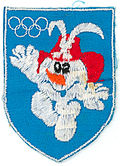
1976 Summer Olympics Montréal Amik Beaver Yvon Laroche,
Pierre-Yves Pelletier,
Guy St-Arnaud and
George HuelOne of the national symbols of Canada. 1980 Winter Olympics Lake Placid Roni Raccoon Donald Moss Its face design resembles the hat and goggles used by competitors. Named for the Adirondack mountain range. 1980 Summer Olympics Moscow Misha Bear cub Victor Chizhikov The bear was the national symbol of the Soviet Union. 1984 Winter Olympics Sarajevo Vučko Little wolf Joze Trobec Symbolizing the desire of humans to befriend animals. 1=According to the IOC, it helped change the common perception in the region of wolves as frightening and blood-thirsty.[citation needed] 1984 Summer Olympics Los Angeles Sam Bald eagle Robert Moore
(from
The Walt Disney Company)The symbol of the United States. 1988 Winter Olympics Calgary Hidy and Howdy Two polar bears Sheila Scott Both represent Western Canadian hospitality. 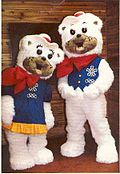
1988 Summer Olympics Seoul Hodori and Hosuni Two tiger cubs Hyun Kim Common in Korean legends. 1992 Winter Olympics Albertville Magique Man-star/snow imp Philippe Mairesse 1992 Summer Olympics Barcelona Cobi A Catalan sheepdog Javier Mariscal Drawn in cubist style 1994 Winter Olympics Lillehammer Håkon and Kristin Two Norwegian children Both are dressed in traditional Norwegian clothes. 1996 Summer Olympics Atlanta Izzy An abstract figure The first computer-generated mascot. 
1998 Winter Olympics Nagano The Snowlets:
Sukki, Nokki, Lekki and TsukkiFour owls Representing the four major islands of Japan. The first syllable of each name combines phonetically to create the word "Snowlets". 2000 Summer Olympics Sydney Olly
(from "Olympic")Kookaburra Matthew Hatton Representing the Olympic spirit of generosity. Syd
(from "Sydney")Platypus Representing the environment and energy of the people of Australia. Millie
(from "Millennium")Echidna Representing the Millennium. All three mascots are common wild animals found in Australia. 2002 Winter Olympics Salt Lake City Powder
(a.k.a. Swifter)Snowshoe Hare Steve Small,
Landor Associates
and Publicis[1]All three mascots are indigenous animals of the U.S. state of Utah, and are named after natural resources important to the state's economy. The animals are major characters in the legends of local American Indians, and their stories reflect these legends. Each mascot also wears a charm around its neck with a petroglyph image to remind them of this heritage.[2] Copper
(a.k.a. Higher)Coyote Coal
(a.k.a. Stronger)American Black Bear 2004 Summer Olympics Athens Athena and Phevos Brother and sister Spyros Gogos Two modern children resembling ancient Greek dolls. 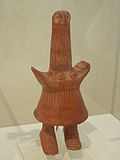
2006 Winter Olympics Turin Neve and Gliz A humanized snowball and ice cube Pedro Albuquerque 
2008 Summer Olympics Beijing The Fuwa:
Beibei, Jingjing, Huanhuan, Yingying, NiniFish, giant panda, Olympic Flame, Tibetan antelope, swallow Han Meilin The five names form the Chinese phrase "Beijing huan ying ni" (北京欢迎你), which means "Beijing welcomes you". Each representing an Olympic ring and Feng Shui element. 
2010 Winter Olympics Vancouver Miga Mythical sea bear Meomi Design
(a group of
Vicki Wong and
Michael Murphy)Part orca and part kermode bear 
Quatchi A sasquatch From Canadian mythology Sumi An animal guardian spirit From Galactic News Mukmuk A Vancouver Island Marmot Not an official mascot, but their designated "sidekick". 2010 Summer Youth Olympics Singapore Lyo and Merly Red male lion(Lyo), Blue female merlion(Merly) Cubix International The two characters are an allusion to the "Lion City" label of Singapore, and the Merlion, a national symbol of Singapore, respectively. 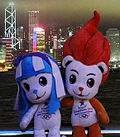
2012 Summer Olympics London Wenlock and Mandeville[3] Drops of steel with cameras for eyes. Iris[4] Named after the village of Much Wenlock in Shropshire - which hosted a precursor to the modern Olympic Games in the 19th century. 2012 Winter Youth Olympics Innsbruck YOGGL Alpine Chamois Florencia Demaría and Luis Andrés Abbiati of Argentina YOGGL represents the character of the host city of these games[5] 2014 Winter Olympics Sochi Bely Mishka (Polar Bear), Leopard, Zaika (the dore hare) Silvia Petrova, Vadim Pak, Anatoli Serdechni 2014 Summer Youth Olympics Nanjing TBA TBA TBA 2016 Summer Olympics Rio de Janeiro TBA TBA TBA 2016 Winter Youth Olympics TBA October 2011 TBA TBA TBA 2018 Winter Olympics PyeongChang TBA TBA TBA 2018 Summer Youth Olympics TBA TBA TBA TBA See also
- Olympic symbols
- Paralympic mascots
- Paralympic symbols
References
- ^ Utah Travel Industry. "2002 Winter Olympics: Emblems and Mascots". http://www.utah.com/olympics/emblem_mascots.htm. Retrieved 3 November 2010.
- ^ Salt Lake Organizing Committee (2001). Reach: An Educators Guide to the Olympic Winter Games and Paralympic Winter Games of 2002. p. 16. http://www.uen.org/k12educator/reach/. Retrieved 20 October 2010.
- ^ Farquhar, Gordon (19 May 2010). "BBC Sport - London 2012 unveils Games mascots Wenlock & Mandeville". BBC Online. BBC Online. http://news.bbc.co.uk/sport1/hi/olympic_games/london_2012/8690467.stm. Retrieved 19 May 2010.
- ^ http://www.irisnation.com/irisnews/work/london-2012-mascots-launched-to-world/
- ^ Innsbruck 2012 [1]
External links
- Official site of the Olympic Movement - Images and information on every game since 1896
- OlympicHistory.info: Mascots (Russian)
- Canadian Olympic Mascots 1976 - 2010
Olympic symbols Summer games ParalympicsWinter games ParalympicsYouth Olympics SummerWinter2012: YOGGLCategories:- Olympic mascots
Wikimedia Foundation. 2010.


